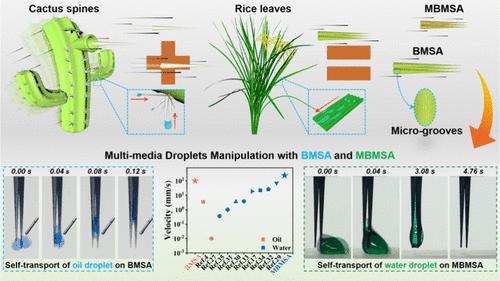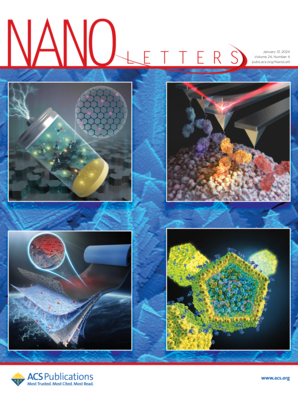利用生物启发微刺阵列实现多媒体液滴的超快自传输
IF 9.6
1区 材料科学
Q1 CHEMISTRY, MULTIDISCIPLINARY
引用次数: 0
摘要
本文章由计算机程序翻译,如有差异,请以英文原文为准。

Ultrafast Self-Transportation of Multimedia Droplets with a Bioinspired Microspine Array
We present a newly developed bioinspired microspine array (BMSA), inspired by the energy gradient in cactus multispines and the liquid film sliding mechanism of rice leaves. Notably, the unmodified BMSA and the modified BMSA (MBMSA) with multiwalled carbon nanotubes (MWCNTs) demonstrate ultrafast directional transport of water and oil droplets, respectively, achieving a transport velocities as high as 102.27 and 237.42 mm/s. These velocities are 1–3 orders of magnitude faster than previously reported values. The structural gradient of the microspines provides the primary driving force for self-transportation, while the MWCNT coating facilitates uniform water film formation, reducing hysteresis resistance. The BMSA demonstrates the capability to separate and collect oil in complex environments and enables efficient antigravity pumping. Additionally, the MBMSA has been utilized in a fog harvesting device (FHD), achieving an impressive collection efficiency of 16,392 mg/h/cm2, representing a 61.62% improvement compared to the original device.
求助全文
通过发布文献求助,成功后即可免费获取论文全文。
去求助
来源期刊

Nano Letters
工程技术-材料科学:综合
CiteScore
16.80
自引率
2.80%
发文量
1182
审稿时长
1.4 months
期刊介绍:
Nano Letters serves as a dynamic platform for promptly disseminating original results in fundamental, applied, and emerging research across all facets of nanoscience and nanotechnology. A pivotal criterion for inclusion within Nano Letters is the convergence of at least two different areas or disciplines, ensuring a rich interdisciplinary scope. The journal is dedicated to fostering exploration in diverse areas, including:
- Experimental and theoretical findings on physical, chemical, and biological phenomena at the nanoscale
- Synthesis, characterization, and processing of organic, inorganic, polymer, and hybrid nanomaterials through physical, chemical, and biological methodologies
- Modeling and simulation of synthetic, assembly, and interaction processes
- Realization of integrated nanostructures and nano-engineered devices exhibiting advanced performance
- Applications of nanoscale materials in living and environmental systems
Nano Letters is committed to advancing and showcasing groundbreaking research that intersects various domains, fostering innovation and collaboration in the ever-evolving field of nanoscience and nanotechnology.
 求助内容:
求助内容: 应助结果提醒方式:
应助结果提醒方式:


